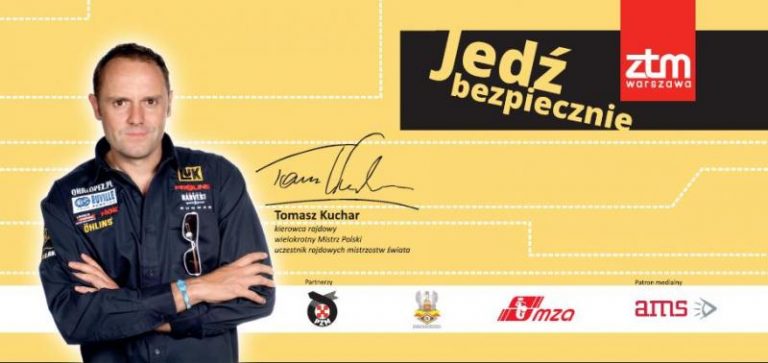
The first edition of ZTM campaign “Drive Safely” is closed. Together with the partners – Polski Związek Motorowy (Polish Motor Union) and Komenda Stołeczna Policji (Warsaw Police Headquarters) we reminded that obeying traffic rules only is not enough to drive safely and quickly in Warsaw. Thoughtfulness during driving and mutual kindness and respect for the road users are also important.
Wojciech Pasieczny, a junior officer from the Traffic Police Department of Warsaw Police Headquarters and Tomasz Kuchar, a rally driver and Polish champion, among others, were warning against bravado on roads and overrating driving skills. City roads are not a racing track. We need a cooperation, and everyone will benefit.
We hope that the drivers of big and small cars, passengers, and pedestrians will keep in mind the Ten Commandments of Safe Travelling prepared by ZTM, and that they will comply with them. A few thousand brochures, which have been distributed among drivers at the car park “Parkuj i Jedź” (Park and Ride) and during road checks by police officers from the Traffic Police Department of Warsaw Police Headquarters, will remind about simple rules that make life and travelling better.
It pays to be kind…
ZTM organizes timetables and plans time necessary for the public transport vehicles to cover a route so as to use the vehicles optimally. It is difficult especially at present when there are many ongoing road investments and the construction of the underground is underway in Warsaw. Despite the fact that there is a 38-kilometer network of bus lanes, the buses have equal rights as private cars on most of the roads so they are stuck together in traffic jams.
There are claims that the timetables do not take into account traffic jams. However, every driver or a passenger knows that a situation can change radically at a minute. As a result, the time needed to cover a route can differ each day by even several dozen minutes. It is not possible to assume the longest time of route covering when planning a timetable because more vehicles would have to operate on the route (the vehicles would be taken from other routes), and a bus would drive very slowly on an empty road. However, a situation when a bus driver adjusts driving to a situation i.e. covers a route faster on one day and on other slower, is also a bad solution. A passenger has only one timetable at a bus stop and expects the transport organizer to be consequent. Therefore, it is very important to show more consideration for buses and facilitate them driving. The drivers who are not willing to travel by public transport will also benefit. In Warsaw approximate number of passengers travelling by a private car is 1.3. The more people will choose travelling by public transport, considering it a fast option of travelling to work, the more space will be on the roads.
… and to be thoughtful while driving
It is not so easy to cope with the recently submitted demands for the trams to have priorities. Such solutions have to be beneficial for the majority – that is for the public transport passengers – but also have to take into consideration other, private vehicles. Time losses will not be eliminated only by reprogramming of the traffic lights. They are also the results of everyday situations including cars blocking the tram routs on the junctions. In such situation, a green light for a tram is insufficient. Drivers should be considerate; they should take into account other vehicles and resign from egoistic behavior.
Driving technique is also important. When a car cuts in a bus or a tram, they have to brake suddenly and cause situations that endanger health or even life of the passengers. The consequences of a fall, especially for a child, a pregnant women, or an elderly person can be really dramatic. The drivers of small vehicles must remember that a tram going 40 km per hour needs 20-40 meters to stop. Also the distance necessary to stop in case of a bus is long. Sometimes hitting a vehicle in front is safer than sudden braking. Drive according to the Ten Commandments of Safe Travelling and you will avoid a situation when such a choice would be necessary.
The Ten Commandments of Safe Travelling
1. Adjust speed to road conditions.
2. Try to predict behavior of the other road users.
3. Always obey the give-way rules.
4. Do not cut in other vehicles. Sudden braking is especially dangerous for the passengers of public transport.
5. Do not block the junctions.
6. Give way to the public transport vehicles that enter the traffic.
7. Pay attention to pedestrians and people who run across the road to catch a bus or a tram, and to those who can come out from behind the other vehicle at a stop right into your path.
8. If you are a pedestrian, do not run into the road, do not come out from behind a bus or a tram unless you are sure the road is safe.
9. Use horn only if necessary, e.g. to draw attention to a dangerous situation.
10. Be kind, self-controlled and show consideration – better arrive late than never.
Published 3 October 2011
Last modified 3 June 2019


